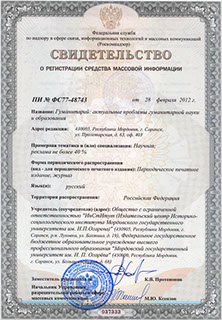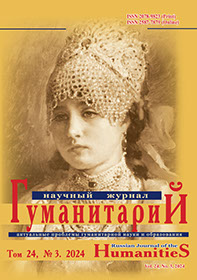ГуманитариЙ актуальные проблемы гуманитарной науки и образования
Russian Journal of the Humanities
ISSN 2078-9823 (Print)
ISSN 2587-7879 (Online)
Navigation
УДК 392.3:008(=511.152)
Galina A. Kornishina
National Research Ogarev Mordovia State University,
Saransk, Russia, e-mail:
G.Kornihina@mail.ru
Home and Family In the Traditional Culture
Abstract
Introduction. The article examines the interaction of the most important components of the traditional life of the Mordovian people – home and family. In the popular consciousness they were inseparable. The house was not just a place for a family to live; here people conducted economic activities, performed ritual actions, and celebrated holidays. To this day, both the family and the living space where it lives retain their ethnic identity; they are part of the cultural heritage of the people. In this regard, their study is important for understanding the modern development of ethnic groups, for solving problems related to the harmonization of interpersonal relationships, raising children, and transmitting spiritual values to them.
Materials and Methods. When conducting the research, we mainly used the comparative historical method, which allows us to trace the phenomena under study over a long historical period, to identify the stages of the emergence of innovations and innovations in the culture of the ethnic group. All this makes it possible to create a comprehensive view of the topic under consideration. A retrospective method was also used, when, based on the study of the components of traditional culture that have survived to the present day, the main elements of the everyday life of the Mordovian family were reconstructed.
Results. The home and the family living in it in a traditional community were perceived as a single system. A unique element of its identification in society were the so-called generic signs (metas), which were used both in the social and economic environment. The economic activity of a traditional Mordovian family was based on a clear division of labor responsibilities, determined by the age and gender of its members. The labor functions of family members largely determined the division of intrahouse space according to gender and age, which was reflected in the allocation here of peculiar “female” and “male” territories.
Discussion and Conclusion. Thus, until the beginning of the 20th century, the Mordvinian family groups represented a single economic community living in a single living space. But gradually, numerous families begin to break up, young married couples move to new homes, where they create their own living environment reflecting the cultural preferences of the ethnic group and its worldview.
Keywords: home, family, generic signs (meta) – teshks, hearth, Kudava, Yurtava, “red corner”, “corner of a woman”, konik, work duties, family separation.
For citation: Kornishina G. A. Home and Family In the Traditional Culture. Gumanitarian: aktual’nye problemy gumanitarnoi nauki i obrazovaniia = Russian Journal of the Humanities. 2024; 24(3): 209–222. (In Russ.)

© Ogarev Mordovia State University. History and Sociology Institute, 2017
68, Of. 411, Bolshevistskaya St., 430005, The editorial office of the scholarly journal «Russian Journal of the Humanities»
Tel.: (8342) 24-25-90; 27-07-11, Fax: (8342) 24-25-90, E-mail: jurnal-econom-hist@isi.mrsu.ru
Designed by A. Napalkov, Email: napalkov@isi.mrsu.ru

